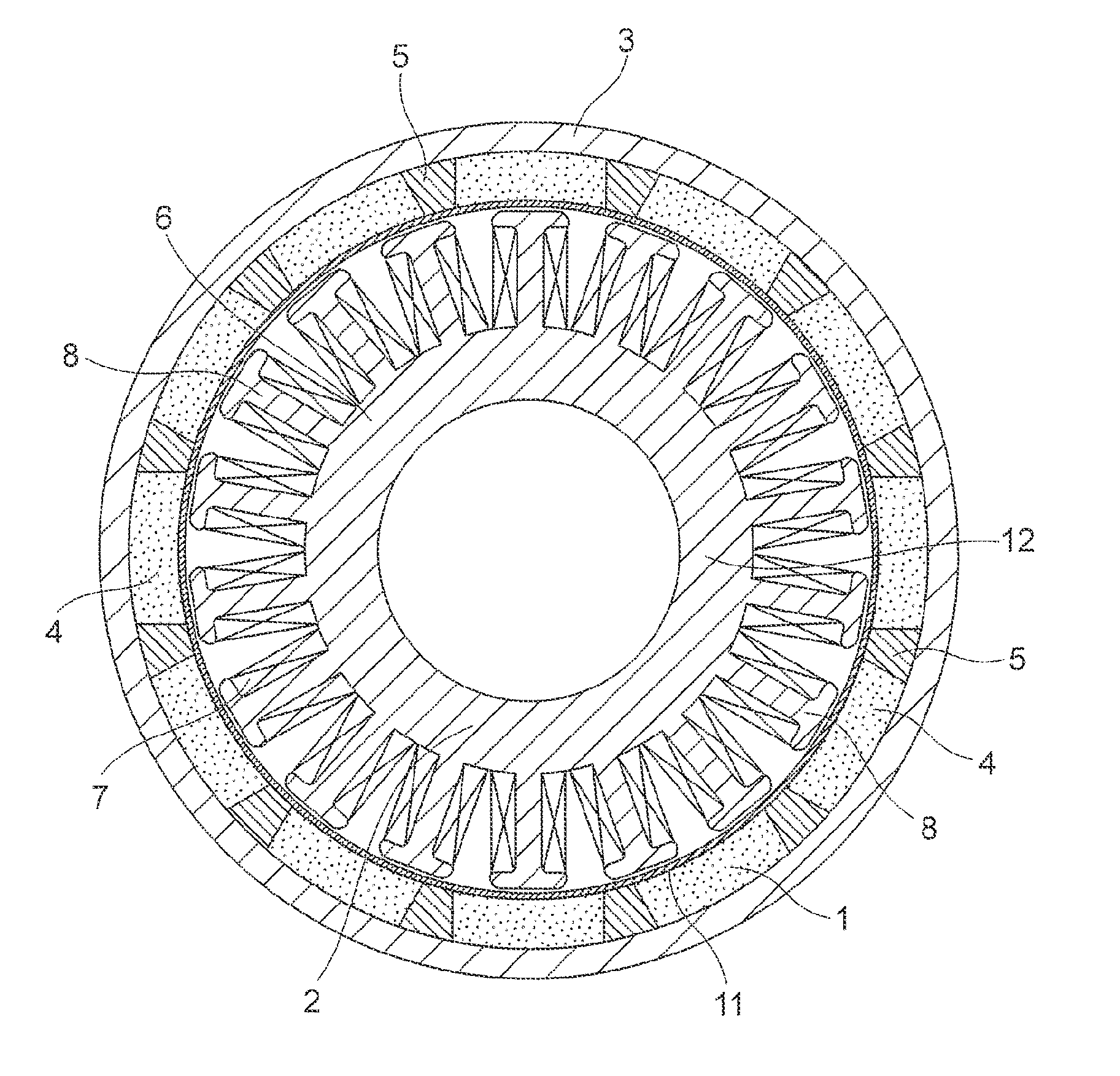Magnet-type rotating electric machine
- Summary
- Abstract
- Description
- Claims
- Application Information
AI Technical Summary
Benefits of technology
Problems solved by technology
Method used
Image
Examples
first embodiment
[0024]FIG. 1 is a front sectional view illustrating an AC generator for a vehicle (hereinafter abbreviated as “AC generator”) which is a magnet-type generator according to a first embodiment of the present invention, FIG. 2 is a partially enlarged view illustrating a rotor 1 illustrated in FIG. 1, FIG. 3 is a partial sectional view illustrating an AC generator which is a reference example, FIG. 4 is a partially enlarged view illustrating the AC generator illustrated in FIG. 1, and FIG. 5 is a partially enlarged view illustrating the rotor 1 illustrated in FIG. 1.
[0025]The AC generator, which is a magnet-type rotating electric machine, includes the rotor 1 and a stator 2. The rotor 1 is connected to an internal combustion engine through a shaft (not shown). The stator 2 is an armature provided inside of the rotor 1.
[0026]The rotor 1 includes a flywheel 3, a plurality of main magnets 4, a plurality of auxiliary magnets 5, and a pole tip 11. The flywheel 3 is a rotary body having a bow...
second embodiment
[0055]FIG. 6 is a front sectional view illustrating a principal part of a rotor 1 of an AC generator according to a second embodiment of the present invention.
[0056]In this embodiment, a concave portion 10 is formed between adjacent main magnets 4A on the outer circumferential side. In the concave portion 10, each of auxiliary magnets 5A is fitted.
[0057]The remaining configuration is the same as that of the AC generator of the first embodiment.
[0058]The auxiliary magnet 5A and the main magnet 4A repel against each other with a strong force. In this embodiment, however, the auxiliary magnet 5A is fitted into the concave portion 10. Therefore, the rotor 1 is prevented from losing rotation balance due to, for example, misalignment of the auxiliary magnet 5 during the rotation of the rotor 1.
[0059]Alternatively, a concave portion may be formed between the adjacent main magnets 4A on the inner circumferential side so that the auxiliary magnet is fitted into the concave portion.
third embodiment
[0060]FIG. 7 is a front sectional view of a principal part of a rotor 1 of an AC generator according a third embodiment of the present invention.
[0061]In this embodiment, a width b of an auxiliary magnet 5B in the circumferential direction is set with respect to a width a of a main magnet 4B in the circumferential direction so that a ratio b / a falls within the range of 1 / 10 to 1 / 2.
[0062]The remaining configuration is the same as that of the AC generator according to the first embodiment.
[0063]By providing the auxiliary magnet 5B, a volume of the main magnet 4B is inevitably reduced. Therefore, if the width b of each of the auxiliary magnets 5B in the circumferential direction is set extremely large, a volume of the main magnets 4B is reduced, which leads to a reduction in the amount of magnetic fluxes of the main magnets 4B, which are linked to the magneto coils 7.
[0064]In view of the above-mentioned problem, paying attention to the relationship between the ratio of the width of the...
PUM
 Login to View More
Login to View More Abstract
Description
Claims
Application Information
 Login to View More
Login to View More - R&D
- Intellectual Property
- Life Sciences
- Materials
- Tech Scout
- Unparalleled Data Quality
- Higher Quality Content
- 60% Fewer Hallucinations
Browse by: Latest US Patents, China's latest patents, Technical Efficacy Thesaurus, Application Domain, Technology Topic, Popular Technical Reports.
© 2025 PatSnap. All rights reserved.Legal|Privacy policy|Modern Slavery Act Transparency Statement|Sitemap|About US| Contact US: help@patsnap.com



